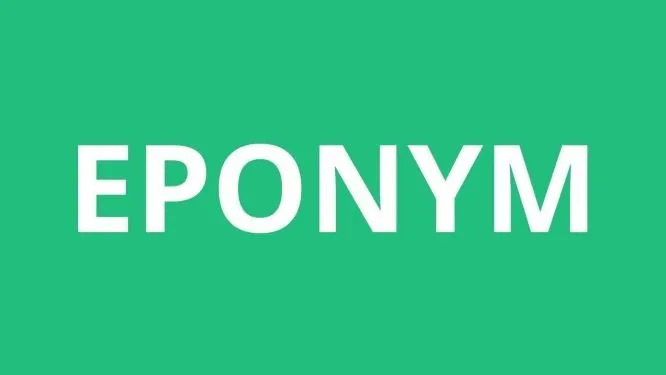
10 Examples of Eponyms in the English Language
What exactly is an eponym? How many of these do we use in everyday speech without even noticing? Explore the most famous eponyms and much more in TheWordPoint's informative blog.

Utilizing figurative language is treated as the true art of speech since applying relevant figurative devices enhances the intended message, implements more complicated meaning, adds clarity or vividness in writing. Reading fiction could be boring in many cases should these figures of speech not enrich texts. Figurative language allows using words beyond their original literal meanings intending to engage the audience, provoke an emotional response, and create a more intense and focused message. This phenomenon implies author’s creativity for proper development and oftentimes requires some critical thinking from readers’ side for proper perception. Opportunities are almost endless, that is why figures of speech are widely used not only in poetry but in a variety of texts you can come across in everyday life.
Depending on the situation, different options can be used to achieve the desired effect on an audience or readers. Knowing and understanding how this phenomenon works in both lingos is also essential for translators since figurative language is not needed in immunization record translation but its relevant translation is vital in fiction books. Message’s meaning can be improved by applying one of the following strategies:
1. Idiom. This is a stable phrase or a words’ group that has a specific and rather different meaning from its constituents’ literal sense meaning. This figurative language meaning is always very particular and usually words cannot be changed without ruining intended message. It should be used in proper context as well.
Examples:
- I have bitten off more than I can chew for this task.
- Speak of the devil, I was just talking about you, my friend.
- It was raining cats and dogs yesterday.
2. Hyperbole. In other words, it is simply an exaggeration but it is the one that creates a humorous effect or cannot happen in real life. People use hyperbole every day oftentimes without even realizing that it is among examples of figurative language.
For instance:
- He was told a million times how to perform this simple task yet he still cannot manage it.
- This car is as fast as a satellite in orbit.
- This man is strong like an elephant.
3. Oxymoron. This device is a perfect example that should be presented once you are asked what is figurative language. It presupposes combining two concepts that have opposite meanings in order to create a new deeper meaning that emphasizes the intended message using new constructions’ seeming absurdity. Texts that include oxymorons should be translated by professional translation services in order to preserve their meaning.
Some examples:
- The silence in a room became so loud she could not bear it anymore.
- A new frigate was damaged by a friendly fire.
- This leader’s favorite way to create controlled chaos and take advantage of it.
4. Synecdoche. This definition of figurative language device is two-dimensional since it can represent the whole of some concept or thing referring to its part or vice versa, using a part to represent the whole.
Examples with explanations:
- Law entered this small livestock town to defend its citizens from bandits (“law” is used to refer to a single person, a sheriff).
- I am going to buy new wheels with a 5.7 engine (“wheels” as the part is used to refer to a car as the whole).
5. Symbolism. Even high school translation requires proper transferring of this strategy from one lingo to another as there might be substantial differences in symbolic meanings of objects in different cultures. Symbolism presupposes going beyond the literal sense of a word or concept. For example, white color is a symbol of cleanliness and purity but in many cultures, this color is the symbol of death and mourning clothing is always white.
More examples:
- An owl symbolizes wisdom.
- Red color represents passion and is often being treated as love embodied as in the case of red roses.
- Sword is used as a concept symbolizing courage and power.
6. Onomatopoeia. According to standard figurative language definition, this literary device suggests that sounds or noises are embodied by words that consist of similar sounds. Usually, one can easily understand what a word means without knowing the term, just listening to it, as these words are pretty self-explanatory and imitate real sounds. Yet this example of figurative language should be translated carefully as different lingos use different phonological contexts.
Some examples:
- Buzz
- Splash
- Zap
- Cuckoo
- Purr
- Hiccup
- Beep
- Bang
- Bark
7. Personification. This phenomenon is very popular among fiction writers and poets as it presupposes giving human qualities and traits to different things, objects, or concepts. It can be widely used in everyday speech to enhance specific meanings or add emotional context.
For instance:
- My car complains a lot when I imagine myself a race driver and add more speed.
- Everybody knows that a large city never sleeps.
- Sun was definitely refusing to get up since it was still dark even though it was 7 AM already.
8. Imagery. Vivid language use is often associated with these figurative language examples because this strategy presupposes using impressive descriptions to appeal to audience’s senses. Complex scenarios and environments, especially in poetry in fiction, obtain more value and create relevant mood once the author profoundly utilizes corresponding imagery.
Example:
The apartments were completely abandoned, and all John could observe were half-demolished furniture, broken toys in the corners, cobwebs all around the place, and a thick layer of dust on all surfaces.
Useful information: Professional Croatian translation services with native translators.
9. Metaphor. This strategy is the inseparable component of literary texts as it helps authors describe an object or person by referring to some other concepts that have very similar features or characteristics. Connection between two things is obligatory, but metaphor does not compare them using word “like”.
Example:
- These warriors are a true rock when they are in this position (both “rock” and “warriors” have a similar feature which is a formidable obstacle).
- Jonathan allowed himself to become drowned in the sea of desperation (both “sea” and “desperation” have a similar feature of being limitless in this case).
10. Simile. Metaphor and simile are figurative language types that people often confuse. It is easy to differentiate them as simile uses terms “like” or “as” to compare two phenomena and enhance intended meaning by using one of the concepts to highlight the other.
Examples:
- My brother grew as tall as a tree.
- This top-notch laptop is as expensive as a new car.
- These warriors provided to be fearsome as hungry lions.
11. Allusion. The list of figurative language does not end with this device but knowing the described ones will enhance one’s eloquence and grasp of the lingo. Allusion will also motivate your audience to use more outside research since this strategy implies referring to a specific situation, person, or event.
Examples:
- This couple’s story is a Romeo and Juliet relationship’s type.
- His smile resembled the one of a Cheshire cat.
- This decision made his life change as if he pulled a sword out of a stone.
Whether it is appropriate application of this phenomenon or avoiding its use, usefulness of different strategies is hard to be underestimated:
- Poets and fiction writers can enrich their texts and implement multiple meanings.
- Using these devices in everyday speech will make your language more colorful.
- Ability to implement devices correctly demonstrates an individual's fluency in language.
- Using USCIS translation service will help you with avoiding including unintentional figures of speech in official documents.
- Using different types of figurative language trains one’s mind and imagination.
Major function is to enhance author’s message and help the audience embrace its full sense whether with the help of emotions or specific images that are associated with used figures of speech. Function of figurative language presupposes creating additional meaning that goes beyond each separate word’s exact meaning which makes both written and spoken language a more versatile tool that helps people understand each other much better. Another function is to create images that could not be otherwise conveyed using literal meaning.
Understanding what does figurative language mean is associated with an individual’s full grasp of a language. Second language learners will be able to enjoy deciphering all hidden meanings in texts and native speakers will have more means of expressing their thoughts at their disposal. It is a truly rewarding experience to discover the world of figurative language and always remember to have your texts translated by professionals so that all figurative devices will be transferred to text in target language without loss of meaning.

What exactly is an eponym? How many of these do we use in everyday speech without even noticing? Explore the most famous eponyms and much more in TheWordPoint's informative blog.

How do you say restroom in French? What’s the Japanese word for grape? If you’re a translator or just speak more than one language you probably answer questions like these frequently. The answers, by the way, are salle de repos and グレープ (gurēpu). You may also be aware that there are words that simply don’t translate well out of or into certain languages. This is even true for English. Keep reading to learn what some of these words are.

There are a few reasons that you may be given the task of writing academic papers in a foreign language. You might be a student in an advanced foreign language class working under the expectation that all work is done in that language.
Your personal account was created successfully. Login details were sent to your email.
Thank you for choosing our service!
You have registered your account successfully!
Your application was sent to our
HR Departament.
Get prepared to pass several proficiency tests to prove your skills as we hire only the best experts to deliver the best quality to our Clients. We will contact you soon for futher instructions